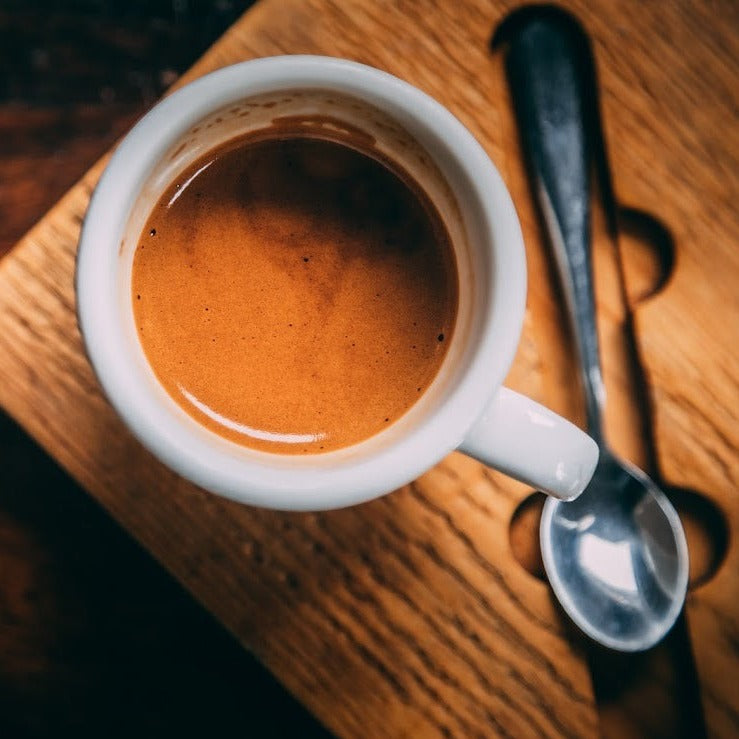SOE Single Origin Espresso – Highlighting Flavors from One Region
SOE Single Origin Espresso – Highlighting Flavors from One Region
Blog Article
Comprehending Coffee Beans: the Trip From Coffee to Blended Coffee Beans

The Origins of Coffee: A Worldwide Point Of View
While you may think about coffee as a contemporary staple, its origins trace back centuries, intertwining with cultures across the globe. The tale starts in Ethiopia, where tale claims a goat herder called Kaldi found the energizing effects of coffee beans after observing his goats romping vigorously after eating them. This sparked rate of interest, bring about coffee's infect Arab investors that valued the brewed drink. By the 15th century, it reached Persia, Egypt, and Turkey, where coffee shops ended up being social centers for conversation and society.
As trade courses expanded, coffee made its way to Europe in the 17th century, rapidly gaining appeal. Each society included its unique twist to coffee preparation, enriching its history.
Cultivation and Harvesting of Espresso Beans
As coffee's journey developed, the emphasis shifted to the growing and harvesting of certain bean ranges, especially those utilized for espresso. You'll find that espresso beans commonly come from Arabica or Robusta plants, each offering unique flavors. The suitable expanding conditions consist of high altitudes and rich, well-drained soil, which improve the beans' top quality.
During the harvest, choosing approaches differ. Timing is crucial; you desire to gather when the cherries get to peak ripeness for optimum taste.
Once collected, the beans are prepared for processing, which is essential in determining their last taste. Recognizing the cultivation and harvesting processes gives you understanding right into what enters into your favored coffee, enriching your appreciation for each and every cup.
Handling Methods: From Cherry to Bean
Currently that you have actually found out about gathering coffee beans, let's discover just how those cherries change into the coffee beans you like. You'll see how various harvesting strategies effect flavor, complied with by the vital actions of fermentation and drying. We'll damage down the milling and grading procedure that identifies your coffee's high quality.
Collecting Methods Discussed
When it comes to coffee, comprehending harvesting techniques is crucial, since they directly affect the taste and quality of the beans you appreciate. There are two main methods: discerning selecting and strip picking. Careful choosing includes hand-picking only ripe cherries, ensuring you obtain the very best quality beans. This technique typically causes a richer taste profile, though it's even more labor-intensive. On the other hand, strip picking methods collecting all cherries at when, despite perfection. While it's quicker and cheaper, this can result in a mix of flavors, influencing the end product. Ultimately, the choice of gathering strategy can considerably affect your coffee experience, so it deserves understanding just how those beans made it to your cup.
Fermentation and Drying Out
After collecting, the following action in handling coffee beans play a considerable function fit their taste. You'll locate that fermentation is vital, as it aids damage down the mucilage bordering the beans, boosting their preference profile. Depending upon the approach, this procedure can last from a couple of hours to several days, with differing results based on temperature and moisture.
When fermentation is total, drying out complies with, which is just as essential. You can select from mechanical or sun-drying drying out approaches. Sun-drying allows the beans to take in flavors from the atmosphere, while mechanical drying guarantees constant wetness levels no matter climate. Appropriate drying out is necessary to stop mold and mildew and maintain the beans' quality, eventually affecting your cup of coffee.
Milling and Grading Process
As fermentation and drying set the stage for taste advancement, the milling and grading process guarantees that just the best coffee beans make it to your cup. This stage includes eliminating the outer layers of the coffee cherry, including the parchment and husk. After milling, the beans are arranged by size and weight, making certain an uniform high quality. You'll discover that grading helps recognize problems and categorize beans, which impacts flavor and fragrance. High-grade beans get a higher quality, leading to a richer coffee experience. Once rated, the beans await product packaging and delivery, maintaining their unique qualities. This thorough procedure is vital for supplying the extraordinary preference you appreciate in every sip of your preferred mixture.
Toasting Techniques: Unlocking Flavor Potential
When you roast coffee beans, the method you pick can substantially affect the taste account. Understanding the partnership between time, temperature, and toasting techniques is crucial to exposing the possibility of your brew. Let's explore exactly how these elements come with each other to create the perfect cup.
Toasting Approaches Clarified
While you may believe that all coffee roasting approaches produce the same outcomes, the fact is that each technique exposes unique taste capacities in the beans. You can choose between approaches like drum roasting, air roasting, or perhaps standard frying pan roasting. Drum roasting uses a rotating drum to evenly distribute warmth, enhancing caramelization and producing a well look at here now balanced taste. Air roasting, on the other hand, distributes hot air around the beans, promoting a lighter roast with noticable level of acidity. Pan roasting enables for hands-on control however requires continuous attention to prevent burning. Each approach has its nuances, so experimenting with different methods can aid you find the perfect roast that straightens with your taste preferences. Appreciate the journey of locating your ideal mug!

Influence On Taste Profile
Different toasting techniques not only affect the procedure however likewise considerably impact the flavor account of the coffee beans. When you select a light roast, you'll experience intense level of acidity and floral notes, showcasing the bean's beginning. On the other hand, a tool roast equilibriums level of acidity with sweetness, commonly revealing chocolatey undertones. Dark roasts, on the various other hand, bring out strong, great smoky flavors, in some cases masking the bean's one-of-a-kind features. Each technique reveals different oils and substances, bring about a wide variety of tastes. By explore various roasting styles, you can discover which profiles resonate with your taste buds. Comprehending these subtleties aids you appreciate the artistry behind your mug of coffee, boosting your overall experience with every sip.
Time and Temperature Level Variables
To release the complete taste possibility of coffee beans, both time and temperature during the toasting process play considerable duties. When roasting, you'll find that greater temperature levels can quickly establish tastes, but if you hurry it, you could wind up with burnt notes. Alternatively, reduced temperature levels allow for a much more steady flavor advancement, showcasing the beans' unique qualities.

Timing is equally as essential; expanding the roast too long can lead to a loss of level of acidity and brightness, while too short a roast may leave the beans underdeveloped. Discovering that wonderful area requires technique and experimentation. By readjusting these elements, you can disclose the rich, complex flavors concealed within each bean, creating a really amazing coffee experience.
The Art of Mixing: Crafting Distinct Coffee Accounts

Begin by choosing a base coffee that offers a solid structure. Then, pick corresponding beans to enhance certain flavor notes. A brilliant Ethiopian bean can bring fruitiness, while an abundant Brazilian coffee adds body. Testing is key-- do not be terrified to adjust proportions till you discover your suitable profile.
As you blend, bear in mind that each mix informs a tale. You're not just making coffee; you're producing an experience. So, take your time, taste regularly, and take pleasure in the journey of uncovering your signature blend.
Brewing Approaches: How Preparation Affects Taste
Blending coffee opens up a domain name of taste opportunities, yet just how you make that mix can substantially affect your final mug. On the various other hand, a pour-over highlights the coffee's quality and illumination, excellent for showcasing delicate notes.
Espresso, with its high stress, generates a focused shot that accentuates sweet taste and crema. If you favor a lighter mixture, think about a cold brew approach; it generates a smooth, less acidic preference.
Inevitably, experimentation is vital. Readjusting variables like water temperature level, grind dimension, and make time can transform your coffee's profile. So, accept the art of developing to uncover the tastes concealed in your coffee blends. The right technique can raise your experience to new heights.
The Future of Coffee: Sustainability and Development
As the coffee sector progresses, sustainability and advancement are ending up being essential for dealing with ecological challenges and meeting customer needs. You'll observe that even more coffee business are adopting environmentally friendly techniques, from sourcing beans morally to executing sustainable farming methods. These changes not just help the planet however additionally enhance the quality of the coffee you delight in.
You could see innovations like naturally degradable product packaging and water-saving developing methods that minimize waste. Advanced modern technology, such as blockchain, is also ending up being preferred, making sure transparency in the supply chain, which allows you to trace your coffee back to its beginnings.
Additionally, buying neighborhood areas and sustaining farmers via fair profession initiatives cultivates a more sustainable coffee ecosystem. As you sip your following mug, keep in mind that your selections can contribute to a brighter future for coffee. By choosing navigate to this website sustainable brand names, you're not simply appreciating a drink; you're making a favorable impact on the world.
Frequently Asked Questions
What Is the Difference In Between Arabica and Robusta Beans?
Arabica beans are smoother, sweeter, and have a greater acidity, while robusta beans are stronger, more bitter, and contain even more high levels of caffeine. You'll discover these differences in flavor and fragrance when making your coffee.
Just How Does Elevation Affect Coffee Bean Flavor?
Altitude impacts coffee bean flavor considerably. Greater elevations create beans with brighter acidity and complex flavors, while lower altitudes typically yield beans that are heavier and less nuanced. You'll discover these differences in your mug!
What Are the Health Benefits of Drinking Coffee?
Consuming alcohol coffee can boost your power, enhance psychological emphasis, and even improve physical efficiency. It's abundant in antioxidants, might reduce the danger of particular diseases, and can advertise a healthier metabolic process when eaten in small amounts.
Can Coffee Beans Be Reused for Developing?
Yes, you can reuse coffee beans for developing, yet the taste might be weak. If you enjoy exploring, attempt reusing them in various means, like cold brews or including in healthy smoothies for an extra kick.
Exactly how Should I Shop Coffee Beans for Freshness?
To keep your coffee beans fresh, save them in a closed container in an amazing, dark area. Prevent exposing them to dampness, warm, or light, as these elements can quickly deteriorate their flavor and aroma.
Understanding Coffee Beans: the Journey From Coffee to Blended Coffee Beans.
Currently that you have actually found out regarding collecting espresso beans, allow's check out exactly how those cherries change into the coffee beans you enjoy.When you roast coffee beans, the method you select can significantly affect the taste profile - Single Origin Espresso.While you may believe that all coffee toasting approaches yield the exact same outcomes, the fact is that each technique exposes special taste potentials in the beans.Various toasting methods not just affect the process however additionally considerably affect the flavor profile of the coffee beans
Report this page